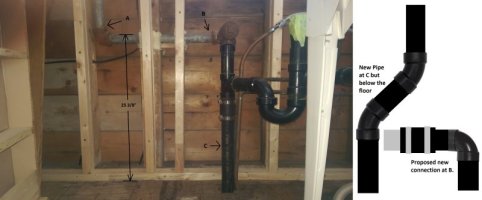GoldMaple
DIY Junior Member
Hello,
I'm renovating my kitchen and I have a few questions. Please refer to the attached pictures for context.
1. I would like to move my drain and hot & cold lines from the floor into the wall. The drain pipe below the floor drops straight to the concrete floor, about 8 feet. Just below the floor it transitions from ABS to galvanized pipe. My plan to move the pipe into the wall is to use two 45 degree elbows as shown in the picture at C. Does anyone see any issues with this approach?
2. As I'm researching how to move the drain pipe I read about vents needing to be 42" off the floor or 6 inches above the sink overflow. My vent is 25 3/8" above the floor. This leads me to a few more questions. (I do have to note that it has worked fine like this for about 60 years.) Anyway.
a. Do I have to raise the horizontal portion of the vent higher?
i. If yes, will the galvanized pipe fall if I cut it at "A"?
b. If the horizontal vent can stay I still have to cut the pipe at B.
i. Is it okay to use a Fernco coupler to an ABS pipe glued to a 45 degree elbow? Like in picture B.
Please advise. Thank you.
Martin
I'm renovating my kitchen and I have a few questions. Please refer to the attached pictures for context.
1. I would like to move my drain and hot & cold lines from the floor into the wall. The drain pipe below the floor drops straight to the concrete floor, about 8 feet. Just below the floor it transitions from ABS to galvanized pipe. My plan to move the pipe into the wall is to use two 45 degree elbows as shown in the picture at C. Does anyone see any issues with this approach?
2. As I'm researching how to move the drain pipe I read about vents needing to be 42" off the floor or 6 inches above the sink overflow. My vent is 25 3/8" above the floor. This leads me to a few more questions. (I do have to note that it has worked fine like this for about 60 years.) Anyway.
a. Do I have to raise the horizontal portion of the vent higher?
i. If yes, will the galvanized pipe fall if I cut it at "A"?
b. If the horizontal vent can stay I still have to cut the pipe at B.
i. Is it okay to use a Fernco coupler to an ABS pipe glued to a 45 degree elbow? Like in picture B.
Please advise. Thank you.
Martin

